Or try one of the following: 詹姆斯.com, adult swim, Afterdawn, Ajaxian, Andy Budd, Ask a Ninja, AtomEnabled.org, BBC News, BBC Arabic, BBC China, BBC Russia, Brent Simmons, Channel Frederator, CNN, Digg, Diggnation, Flickr, Google News, Google Video, Harvard Law, Hebrew Language, InfoWorld, iTunes, Japanese Language, Korean Language, mir.aculo.us, Movie Trailers, Newspond, Nick Bradbury, OK/Cancel, OS News, Phil Ringnalda, Photoshop Videocast, reddit, Romanian Language, Russian Language, Ryan Parman, Traditional Chinese Language, Technorati, Tim Bray, TUAW, TVgasm, UNEASYsilence, Web 2.0 Show, Windows Vista Blog, XKCD, Yahoo! News, You Tube, Zeldman
Huayna Picchu Trek: The Stairway of Doom in Peru 6 Mar 2025, 9:14 am
The hike up Huayna Picchu in Peru can be somewhat daunting and intimidating at times, but it is undoubtedly one of the top experiences in Machu Picchu, the famed lost city of the Incas.
This hike is a must-do on your bucket list, leading you to the peak of Wayna Picchu (the famous mountain located behind Machu Picchu), where you can explore original Inca structures and enjoy breathtaking panoramic views.
Don’t let the nickname frighten you—despite being referred to as the ‘stairs of death’ due to their steepness and narrowness, there have been very few incidents over the years, and it’s generally safe as long as you don’t act irresponsibly.
This travel guide will detail the route to Huayna Picchu mountain, provide tips for safely navigating the ‘stairs of death’, and cover all the important information you should know before your journey!
Huayna Picchu: Quick Facts
- Difficulty: Moderate / Hard
- Distance: 4 kilometers (2.5 mi) round trip
- Elevation Gain: 305 meters (1,000 ft)
- Top Elevation: 2,693 meters (8,835 ft)
- Duration: 2 – 3 hours round trip
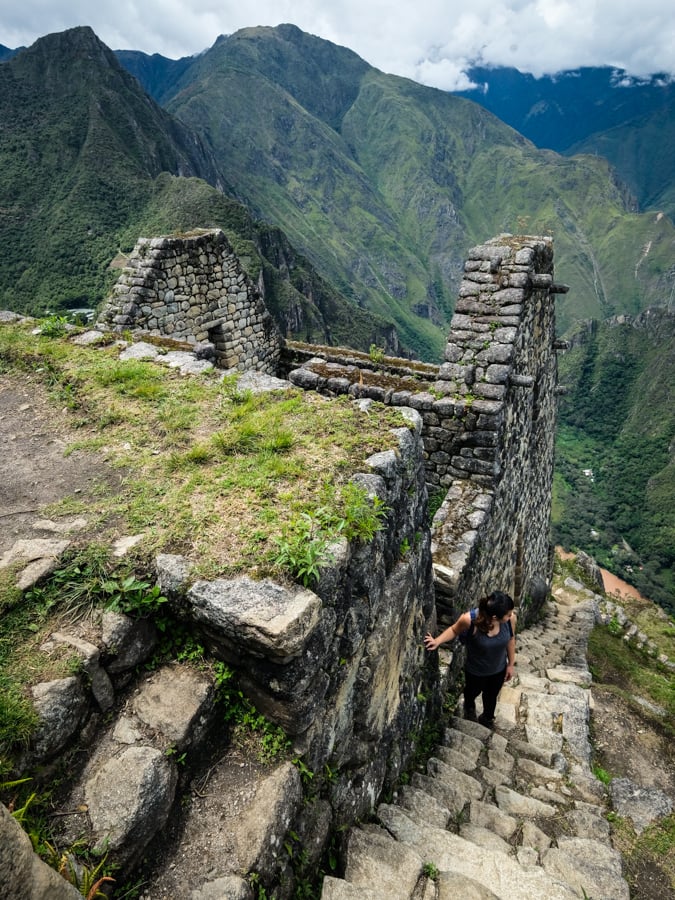
What Is the Meaning of Huayna Picchu?
The term ‘Wayna Picchu’ originates from the Quechua language, translating to ‘young mountain’ (‘wayna’ means young, and ‘picchu’ signifies mountain). A commonly used alternative spelling is ‘Huayna Picchu,’ which is more frequently seen on the internet today.
Location:
Huayna Picchu is the mountain situated behind the renowned Machu Picchu citadel in Cusco, Peru, which was inhabited by the Incas during the 15th century.
This mountain is often mistaken for Montana Machu Picchu, another peak nearby that you can hike, but Huayna is truly the recognizable mountain visible just behind the ruins when you arrive at the citadel and stand at the well-known viewpoint. To get to Huayna Picchu and begin your hike, you must first stroll through the ruins of Machu Picchu, as the trail starts on the northern side of the park.

Huayna Picchu Hike: What to Anticipate
The Huayna Picchu trek is a picturesque path that leads you up a mountainside covered in jungle, featuring stone stairways constructed by the medieval Inca civilization.
While it can be somewhat demanding, it is completely non-technical, and physically fit hikers can reach the mountain’s peak in an hour or less. The steepest steps are located towards the end of the journey, close to the summit.
Despite its challenges, this trail is very popular and is restricted to only 400 hikers each day, which means you frequently need to reserve a spot several months ahead of time. The following details will outline every aspect of the hike and what you can anticipate. It’s a memorable adventure!
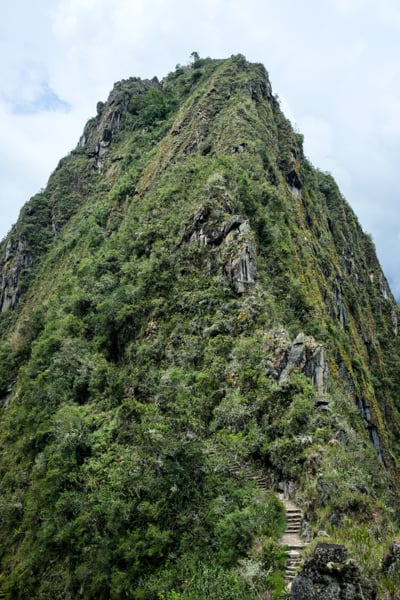

Trail Commencement
The beautiful views begin right away on the Huayna Picchu trek.
Immediately, you are treated to stunning views of Putucusi mountain and the Urubamba river, surrounded by a series of dramatic green peaks in the background. From this point onward, there is essentially a single pathway to reach the summit of Huayna Picchu, with numerous fellow international hikers making their way in the same direction, ensuring you won’t lose your way.
The remainder of the trek involves a continuous ascent on Inca stone steps, though many of the switchbacks offer enough foliage to provide some respite from the sun. While these stone steps aren’t in the best shape, they still make the journey somewhat easier compared to hikes without steps, where you would be navigating through dirt or mud.

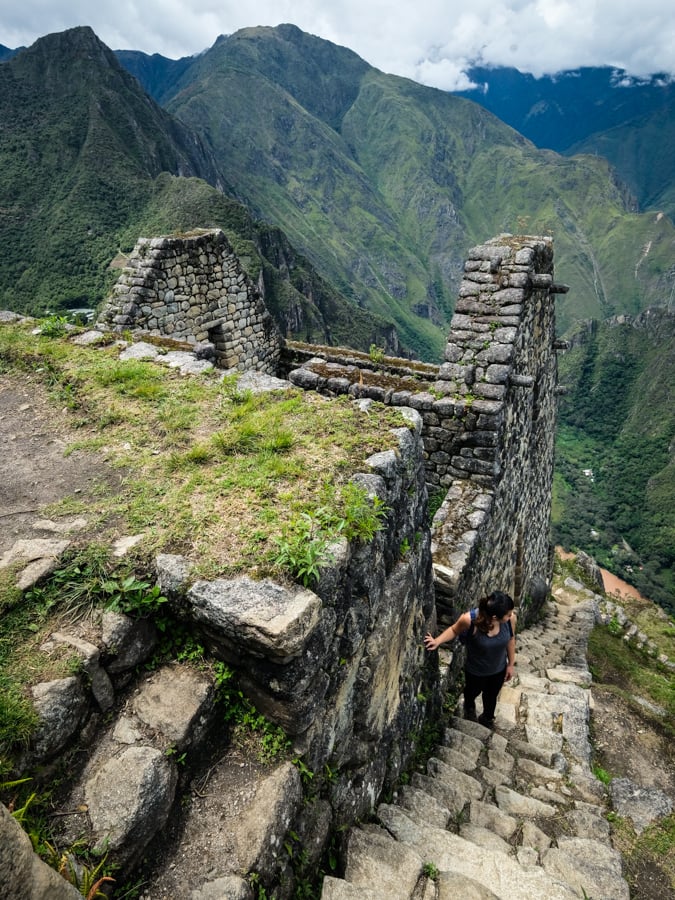

Inca Structures
After hiking for around 20 to 30 minutes, you’ll catch your first glimpse of the Machu Picchu citadel in the distance, a reminder of how high you’ve already climbed!
At this juncture, the stairway becomes significantly steeper and narrower, so there’s a steel cable for additional support. While the stone steps remain stable, their small size can be somewhat cumbersome.
Here, you’ll also come across your first Inca buildings and terraces along the trail, which you’ll pass as you make your way to the summit of Huayna Picchu mountain.
Local lore suggests that these structures were once home to the priests of Machu Picchu.
Many of these Inca structures are accessible to the public, allowing you to explore them at your leisure and take a moment to relax before continuing your hike up Huayna Picchu. A few of the structures feature windows that offer breathtaking views of the Andes mountains. What would life have been like in this lofty place? Can you envision it?
We wished we could linger longer and investigate these ruins for hours, but our anticipation to experience the grand climax of this hike — the Huayna Picchu ‘Stairs of Death’ — and reach the summit was too strong!




Machu Picchu Stairs of Death
Now it’s time to tackle the ‘stairs of death’! This remarkable stone staircase presents your final obstacle before attaining the peak of Huayna Picchu mountain.
Despite its daunting name, there’s no immediate danger here; the pathway is quite wide. Nonetheless, the views can be disorienting! There are some steep drop-offs, but they’re not as perilous as they appear. Even if you were to fall off the stairway, you’d land safely on one of the grassy terraces below.
The exact number of steps remains uncertain, but many are unevenly shaped and quite short, so you may find it challenging to place your entire foot on them at times. The flow of traffic on this stairway is one-way (upward), with multiple spots to step aside and allow others to pass, so there’s no need to rush through it.
These stairs were the highlight of the entire Huayna Picchu hike for me. We could have easily spent nearly an hour here, simply enjoying the scenery and attempting to snap photos that reflect the breathtakingly steep landscape.
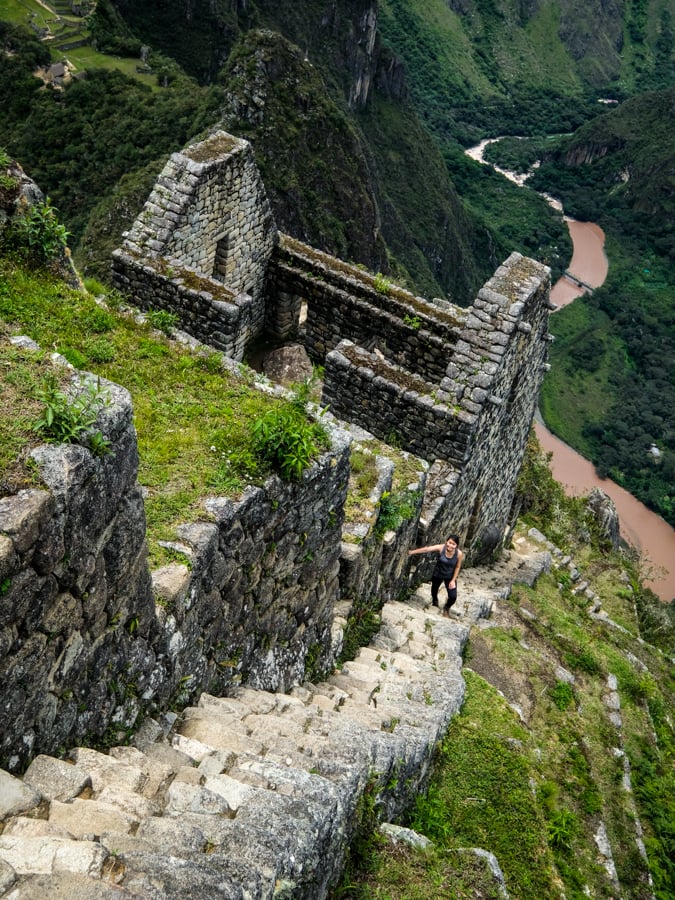
Cima de Huayna Picchu
Después de recorrer una corta distancia más allá de la última escalera de piedra, ¡llegarás a la cima de la montaña Huayna Picchu!
La altitud del pico es de 2,693 metros (8,835 pies) y puedes disfrutar de vistas espectaculares de Machu Picchu y de las serpenteantes curvas de la carretera de autobús que conduce a la ciudadela.
Estarás rodeado por las montañas de los Andes en todos lados. También puedes observar la montaña Huchuy Picchu (que se ve diminuta abajo) y el puntiagudo pico de Montana Machu Picchu.
En mi opinión, es una de las mejores vistas en todo Perú, y si llegas a la cima en un momento concurrido, es posible que debas hacer fila aquí para tomar fotos.
Ten cuidado en la parte superior de la montaña porque, nuevamente, hay algunos acantilados pronunciados si no tienes precaución. Normalmente hay un guardabosques instalado en la cima para asegurarse de que la gente no realice actividades peligrosas.
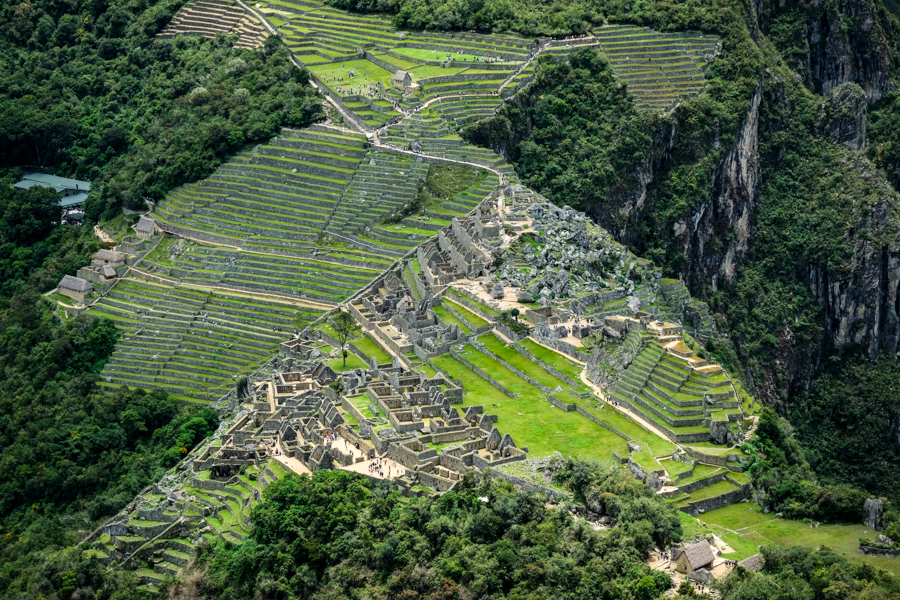

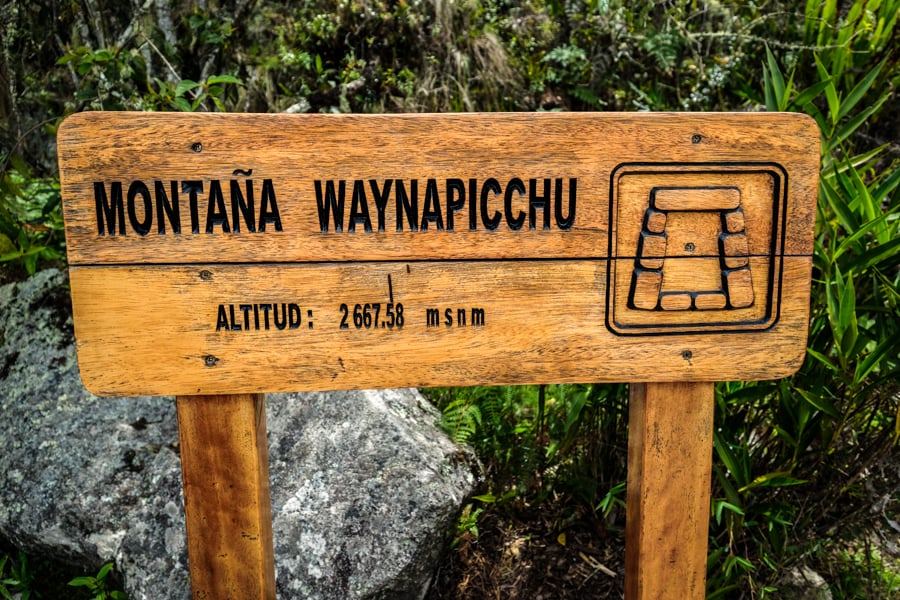

Temple of the Moon
Shortly after reaching the peak of Huayna Picchu mountain, keep an eye out for a side trail that leads around the back of the mountain.
This route takes you to the Temple of the Moon (Huaca de la Luna), an ancient ceremonial site located within a cave that may have once housed mummies. This intriguing cave temple is an optional diversion from the main trail on Huayna Picchu mountain, and while it isn’t always accessible to hikers, it’s definitely worth seeing if you get the chance. If you plan to explore this side trail, be sure to allocate an additional 2 hours to your overall hiking time at Wayna Picchu.
The Tunnel
As you descend from the summit of Huayna Picchu mountain, you’ll encounter a short, narrow tunnel you must pass through to return to the main trail. This passage is quite small at the entrance, so you might need to take off your backpack and crawl to squeeze through. It’s an interesting little aspect of the hike that we found quite enjoyable. Once you emerge from the tunnel, the path reconnects with the original trail, allowing you to make your way back down to the start of the Huayna Picchu hike.

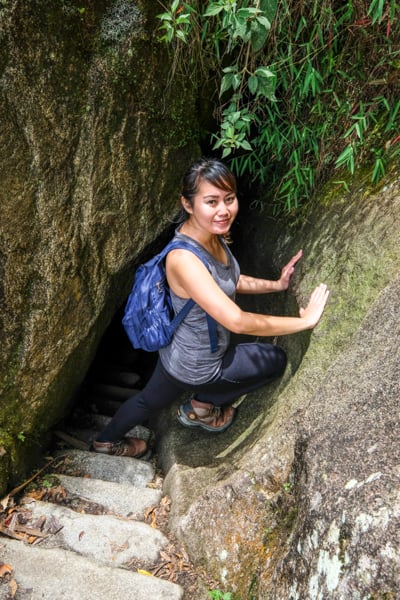
Huayna Picchu Challenge
The hike is tough, but it’s not excessively difficult or perilous. It resembles using a stairmaster more than tackling a via ferrata. We anticipated it to be more challenging based on what we had read online.
The primary difficulty at Huayna Picchu lies in the steepness of the stairs and the altitude, which can make breathing more difficult. However, if you’ve taken a few days to adjust in Peru, altitude shouldn’t pose a significant issue.
To prepare for this hike, focus on climbing plenty of stairs!

Is Huayna Picchu Safe?
Huayna Picchu is generally a safe hike if you take care, but I wouldn’t advise it for small children, older individuals who aren’t fit, or anyone who lacks stability and confidence with heights. Safety measures have enhanced in recent years.
In the past, the loop section close to the summit was traversed in the opposite direction, which meant descending the ‘stairs of death’ rather than climbing up. As you can imagine, this was more intimidating and challenging than the current configuration!
Regardless, countless individuals conquer the mountain daily, and incidents are quite uncommon. No specialized skills are required; merely a decent fitness level will suffice.
While this hike may not suit everyone, if you love adventure, photography, and a thrill of excitement, you should certainly include it in your bucket list for Peru!


Accidents and Fatalities at Wayna Picchu
The internet is full of exaggerated tales regarding the fatality rate at Wayna Picchu, but most of these accounts and statistics appear to be inaccurate.
Nonetheless, here are a few verified accidents:
- In 1997, a 68-year-old American tourist fell and died near the peak of the Huayna Picchu trail. (Source: UPI)
- In 2004, a Russian tourist was killed by a lightning strike on the mountain. (Source: Washington Post)
- In 2009, a 66-year-old American tourist suffered “massive internal injuries” after falling from “a mountain above Machu Picchu,” but it’s unclear whether this incident occurred on Wayna Picchu, the Inca Trail, or Montana Machu Picchu. (Source: ABA Journal)
- In 2014, a Belgian tourist allegedly died while hiking Huayna Picchu, though the details remain unknown, leaving the circumstances uncertain. (Source: Washington Post)
- In 2016, a German tourist fell 200 meters to their death while ‘jumping in the air’ to take stunt photos near a cliff’s edge. Again, it’s undetermined if this happened at Wayna Picchu or Montana Machu Picchu. (Source: NY Daily News)
There have been numerous fatalities at Machu Picchu over time, but upon closer examination, most of these incidents took place on the Inca Trail or within the citadel itself, and the context was usually atypical.
The leading causes of death at Machu Picchu historically include heart attacks, falls, lightning strikes, rockfalls, and accidents while taking selfies — generally in that order.
While these accidents are undoubtedly tragic, it’s important to remember that millions visit Machu Picchu annually, and typically there are no deaths reported each year at either Machu Picchu or Huayna Picchu.
Ways to Hike Huayna Picchu Safely
What are some strategies you can use to ensure your safety and reduce risks while hiking Huayna Picchu?
As you can see from the previously mentioned accounts, it’s important to approach the mountain with a healthy dose of respect. The danger of a hike like this often stems from being overly carefree or attempting to take selfies near a cliff’s edge. It’s essential to wear appropriate footwear, avoid mountain hikes during thunderstorms, and refrain from tackling trails that exceed your physical limits. If you’re still uncertain about Huayna Picchu, consider hiring a private tour guide for the hike; this way, you’ll have someone knowledgeable to share insights as you progress.
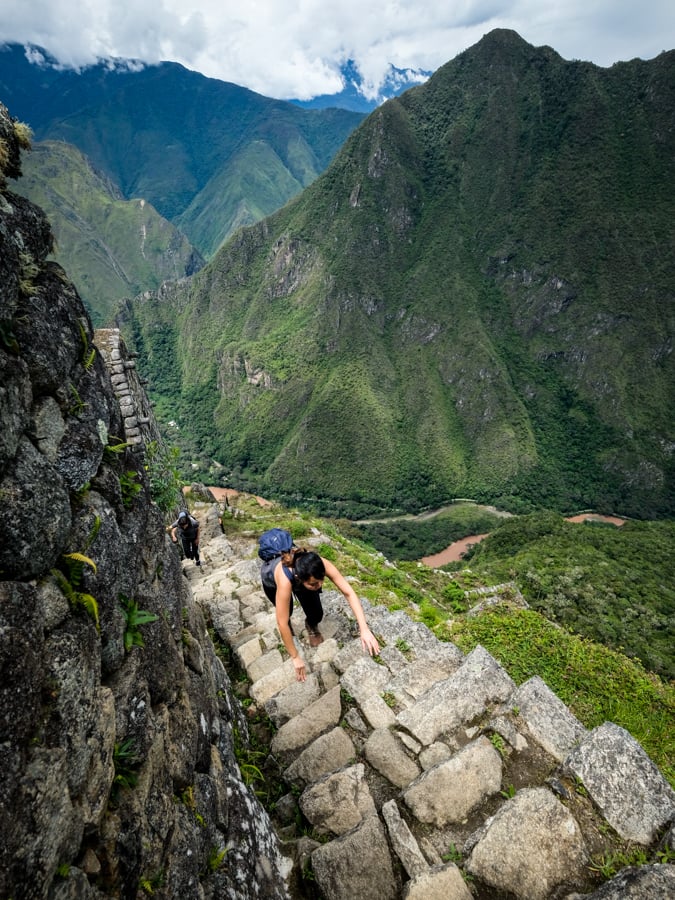
What You Should Bring
Footwear. This trail isn’t suitable for flip flops. Hiking boots are ideal if you have them, but at the very least, you should wear shoes with good traction for Wayna Picchu.
Water. Aim to bring at least 1 liter of water for each person. Staying hydrated at high altitudes is crucial.
Snacks. We packed some granola bars and enjoyed them at the summit after ascending the stairs.
Sunscreen. The sun’s intensity increases with altitude, so it’s essential to have sunscreen and a hat to prevent sunburns.
Rain Gear. A poncho or raincoat is wise to pack, especially if you’re visiting during the rainy season.
Insect Repellent. We didn’t bring any bug spray and ended up with a few bites, so it might be useful to carry some.
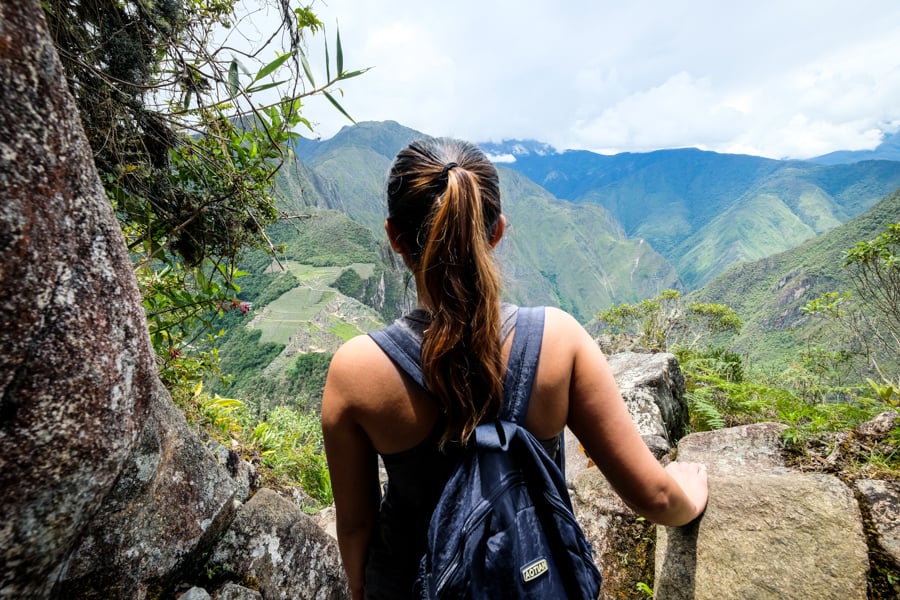

Huayna Picchu Tickets: How to Acquire Them
A permit is necessary to hike Huayna Picchu, with only 400 permits available each day to reduce trail congestion. These permits can only be purchased online.
Due to the combination of this limitation and the trail’s immense popularity as a must-do experience, it’s likely you’ll need to reserve your tickets several months ahead of time to ensure availability. Tickets can be purchased through the official Machu Picchu ticket website (https://tuboleto.cultura.pe) or via the GetYourGuide tour platform. The official site tends to be slightly less expensive, but it is entirely in Spanish and has a rather confusing layout.
One significant advantage of booking through GetYourGuide is that tickets are fully refundable if you decide to change your plans prior to your visit. In contrast, our experience with the official Machu Picchu website staff has shown them to be somewhat reluctant when it comes to refunds. Additionally, GetYourGuide offers a more user-friendly experience in English, while the official site is exclusively in Spanish at the moment.
Both sites are trustworthy, and you can choose either one for your ticket purchase. A local tour guide isn’t necessary for this hike; you simply need your tickets. However, if you wish, you can always hire a guide at the entrance of Machu Picchu who, after a price agreement, will join you in the ruins, provide explanations, and take photos on your behalf.

Hours & Fees
The whole Machu Picchu area is open from 6:00 AM to 5:30 PM daily. Stays are supposedly limited to a few hours, but the staff doesn’t enforce this, and as long as you aren’t causing a problem you can pretty much stay as long as you like.
For the Huayna Picchu hike, tickets are split up into four different entry times in order to reduce congestion on the trail. For each of these time slots, 100 tickets are available (400 total per day).
Choose a time slot that suits you, and keep in mind it only affects when you’re required to enter. Once you’re inside the control gate for Huayna Picchu, you can stay as long as you like.
The current adult ticket price for Huayna Picchu is 200 soles (~$52 USD) as of 2025, and that gives you entrance to the mountain and also Circuit 4 of the Machu Picchu ruins. Students and minors (ages 3-17) get a 50 percent discount.

Route Map
This route map illustrates the way to reach Huayna Picchu from the primary entrance of the citadel. You can click on the image to view it in a larger size.
Note: The route underwent minor modifications in 2024. You can find the updated map in PDF format here.

How To Get To Huayna Pichu Mountain
The hiking trail for Huayna Picchu is located on the north side of the Machu citadel, behind a control gate that you also pass to reach the Huchuy Picchu hike. You can see the route map above for a general idea of where to go, but be prepared to ask the staff for directions, because even with a map it can be a bit tricky to find if you’re in a hurry.
Ensure you arrive at the main entrance gate of Machu Picchu at least an hour prior to the entry time listed on your hiking ticket. There may be lines at the citadel’s entrance, and it could take 15-30 minutes to walk from the entrance to the Huayna Picchu control gate. It’s crucial to be on time, as arriving late means you risk losing your tickets; the staff is quite strict and won’t allow entry to the Huayna Picchu control gate if you’re even a minute late compared to the time stated on your hiking ticket (it can be frustrating, I understand).
Once you reach the control gate, you will need to sign your name on the guest list both before and after your hike, in case anyone goes missing during the trek. After that, the trail is clearly marked with signs directing you toward Huayna Picchu, which soon diverges from the path to Huchuy Picchu. From this point onward, the route is straightforward.
Is Wayna Picchu Worth It?
Absolutely, this hike is definitely worth it!
It offers a fantastic blend of breathtaking views, historical significance, excitement, and a challenge. We thoroughly enjoyed this hike and I hope to experience it again in the future. It feels straight out of an Indiana Jones adventure.
Furthermore, it’s enjoyable to see the iconic photos of Machu Picchu and realize that you’ve climbed the mountain right behind it.
When to Hike Huayna Picchu
Typically, the optimal time for hiking at Machu Picchu is during Peru’s dry season, which extends from May to October. This period generally offers sunnier days and significantly reduced rainfall.
That said, the rainy season shouldn’t be entirely discounted. We hiked during January and had pleasant weather. Rain typically occurs in the afternoons or evenings, so it’s wise to pack a poncho just in case.
In my view, the ideal time of day to ascend Huayna Picchu is late morning. This is when the morning mist tends to dissipate, providing clearer views of the Andes mountains.
Machu Picchu Tour Options
If you’re looking for a pre-arranged tour for your trip to Machu Picchu, there are many excellent choices available online. GetYourGuide offers full-day tours of Machu Picchu departing from Cusco (either private or with a group), along with amazing mountain hikes such as Huayna Picchu, which requires advance booking due to its popularity. We’ve utilized this company for various tours and activities in Peru, and they are exceptional. Highly recommended!
Machu Picchu Hiking Options
This hike is part of the many trails available at the Machu Picchu citadel in Peru.
Machu Picchu Mountain: The tallest mountain in the region, and the most challenging to ascend. The peak stands at an elevation of 3,082 meters (10,111 ft).
Huchuy Picchu Mountain: A brief and relatively straightforward hike leading to the summit of a small mountain located behind the citadel.
Huayna Picchu Mountain: This is the most renowned and breathtaking hike at Machu Picchu. The peak elevation is 2,693 meters (8,835 ft), but to get to the top, hikers must navigate the infamous ‘Machu Picchu Stairs of Death.’
Inca Sun Gate: Also referred to as Inti Punku, this moderate hike provides access to a scenic viewpoint at an Inca gate that was originally the principal entrance to Machu Picchu.
Inca Bridge: This quick hike offers an easy detour to view a bridge that once served as the secret back entrance to Machu Picchu.
Inca Trail: For a truly grand arrival at Machu Picchu, think about the Inca Trail. This iconic multi-day hike in Peru spans 1 to 7 days (based on your starting point), culminating at the Machu Picchu citadel. A significant portion of the trail follows paths constructed by the Incas.
Putucusi Mountain: A perilous, unmaintained ladder trail leading to the peak of Putucusi, which has a distinctive arrowhead shape and can be viewed across the river from Machu Picchu. Sadly, the main ladder for this hike was damaged by severe weather over 4 years ago, making it infrequently climbed nowadays. It is hoped that the route will be restored in the future.
Additional Activities in Machu Picchu
Thank you for reading! I trust you found this travel guide on the ‘stairs of death’ at Huayna Picchu mountain in Peru enjoyable.
Be sure to explore my comprehensive list of the top activities to experience in Machu Picchu during your visit!
How to Explore the Pyramids of Giza and the Sphinx in Egypt 6 Mar 2025, 6:05 am
What kind of bucket list would be complete without the Great Pyramids of Giza in Egypt? Surprisingly, visiting the Giza pyramids is quite manageable on a day trip from Cairo, the capital city of Egypt. Constructed in 2560 BC, the Great Pyramid of Giza held the title of the tallest man-made structure in the world for 3,800 years.
It is the oldest of the Seven Wonders of the Ancient World and the only one that remains intact today. Exploring the Egypt pyramids is a relatively straightforward experience; while there isn’t much to do except admire the massive stone structures, it’s still an impactful and unforgettable experience that every traveler should include in their journey.
This travel guide will detail how you can explore the Egyptian pyramids independently, whether you choose a tour or not, all while keeping a tight budget and requiring little preparation!
Quick Facts (Main Pyramid)
Builders: 200,000+
Date: 2560 BC
Height: 150 meters (500 ft)
Base Length: 150 meters (500 ft)
Weight: 6 million tons
No. of Blocks: 2.3 million
Top Day Tours to the Pyramids of Egypt
If you’re pressed for time and wish to bypass the hassle of organizing your own visit to the pyramids or prefer the safety and ease of traveling with a group, you have some options available.
Several companies provide organized day tours to the Pyramids of Giza and the Sphinx, starting at just $45 USD. The tour includes hotel pick-up, an optional camel ride, and a return to Cairo on the same day.
If you prefer to plan your own experience and explore independently, that option is discussed next.
How to Reach the Giza Pyramids
The Great Pyramids are situated on the edges of Giza, a district in Cairo, Egypt. The closest airport is Cairo International Airport (CAI), which is connected by numerous international airlines. You can find flights to Cairo on Skyscanner.
From Cairo airport, it takes about an hour to drive to Giza. The arrivals area has numerous taxis available, but I opted for Uber and would strongly recommend it since it’s generally more economical and likely safer as well.
Unless you are accustomed to driving in the Middle East, it’s best not to rent a car in Egypt! The traffic in Arab nations can be perilous and unpredictable, so you’d be better off hiring a driver who understands the local driving conditions.
Moreover, drivers in Egypt are quite reasonably priced — as of 2025, the fare for an Uber trip from Cairo to Giza can be as low as 340 EGP (around $7 USD).
Giza Pyramids: What to Anticipate
If you plan to stay in Giza for at least a night, which I suggest, you can first leave your luggage at your hotel and then comfortably walk to the entrance of the pyramids and the sphinx.
Several hotels in Giza are just a 5-minute stroll from the main entrance to the pyramids, and they typically offer fantastic rooftop views as well. There will be more details on that later.
When you’re ready to explore the pyramids, simply make your way to the main ticket office to purchase your tickets. You’ll encounter scammers and touts trying to engage you in conversation, but it’s best to ignore them.
As of 2025, a general ticket costs 540 EGP (approximately $11 USD), which allows you access to both the sphinx and the surrounding area of the pyramids.
If you intend to explore the interiors of the pyramids rather than merely observing them from the outside (which is what I chose to do), you will need to purchase an additional ticket.
The cost is 220 EGP for entry into the pyramids of Khafre and Menkaure, or 900 EGP for the pyramid of Khufu.
In my opinion, spending extra for these tickets isn’t worth it. The heat inside can be quite oppressive, and the chambers were largely robbed by tomb raiders long ago.
It would be a wiser decision to save that money and visit the Egyptian Museum or some attractions in Luxor, where you can still admire the intricate tombs and gold artifacts.
At this stage, you will have arrived at the pyramids and acquired your tickets. Security checks at the entrance are relatively quick, and the wait times are minimal.
Just keep an eye on your belongings. One time, I had cash taken from my wallet while it was being processed through one of those x-ray machines in Egypt.
You’ll need to choose whether to visit the sphinx first or the pyramids.
The sphinx is located close to the entrance, while the pyramids require a 15-20 minute walk from there. I suggest taking a camel ride to the pyramids, and then you can circle back to stop by the sphinx on your way out.
Beware of scams! Giza is notorious for scammers and aggressive sellers, just like other tourist spots in Egypt.
Be ready to face persistent harassment from dubious individuals claiming you can’t explore the pyramids without a guide (which is false), insisting you need their services (also false), or promoting their camel rides as the best available (well, maybe).
I once agreed to a camel ride only for the guy to try to put me on a horse instead, claiming it was just as good — no way! Just stand your ground and make it clear that you won’t pay unless you receive what you agreed upon.
Camel Rides at the Pyramids of Egypt
If you decide to take a ride on a camel or horse, which I believe is a fantastic choice, be sure to agree on your price and terms BEFORE getting on.
It’s usual for the touts to concoct outrageous prices once you’re already on the camel and feeling pressured. Always wait to make your payment until after your ride, regardless of what they claim! As of 2024, the Egyptian government has set a standard rate for camel rides at 500 EGP (~$10 USD) for one hour. There is a notice near the entrance stating this, and you can always refer to it if you’re struggling to negotiate a reasonable price with the touts.
You can ask your guide to take some photos of you on the camel with your camera, but be ready to give a tip for this; adding around 50 EGP should suffice.
Your guide may ask for a lot more and might become rude or forceful, but that’s just how things are in Egypt.
Just agree on a price beforehand and stick to it. Even the most persistent touts will back off when they see that you are steadfast. This is a common aspect of life and travel in Egypt.
Just so you know, 50 Egyptian Pounds is an excellent price for a camel ride.
I’ve explored many areas in the Middle East, and I can confidently say that the camel rides in Giza are significantly less expensive than those in more developed regions like Dubai or Oman! So, if you’re looking to experience riding a camel, this might be the best spot in the world for it.
I enjoyed two camel rides at Giza – one lasting 30 minutes and the other for 60 minutes – and both were fantastic. Riding camels can feel a bit intimidating since you’re so high up, but it’s truly an amazing experience.
Moreover, you can share stories about your adventure of riding a camel at the Great Pyramids of Egypt – it’s legendary!
The Grand Sphinx of Giza
Be sure to visit the Grand Sphinx as well.
This legendary beast, featuring a lion’s body and a pharaoh’s head, is the most ancient sculpture still standing in Egypt. It is also part of the same 120 EGP ticket you purchased at the pyramids’ entrance, so simply present your ticket at the sphinx’s entrance, and you can approach it.
Outside, there’s a fantastic photo opportunity by the gate, where you can capture a front shot of both the sphinx and the Pyramid of Khafre together (as shown in the picture above).
Unfortunately, during my visit, I couldn’t get a complete profile shot of the sphinx’s body and paws because it was covered in scaffolding, likely in preparation for the visit of U.S. First Lady Melania Trump, who was expected the following week.
Don’t forget to take a moment to admire the enormous stone blocks at the entryway! The weight of those blocks must be incredible.
Hotels Near The Egyptian Pyramids
There are a bunch of neat hotels in Giza that are within a 5 minute walk to the main entrance for the pyramids, and they usually have awesome rooftop views of the whole area.
I would highly recommend staying at least one night in Giza, because it allows you to go at a relaxed pace and make the most of your time there.
It also allows for an effortless experience of the Sound & Light Show, or simply relaxing and enjoying the sunset at Giza.
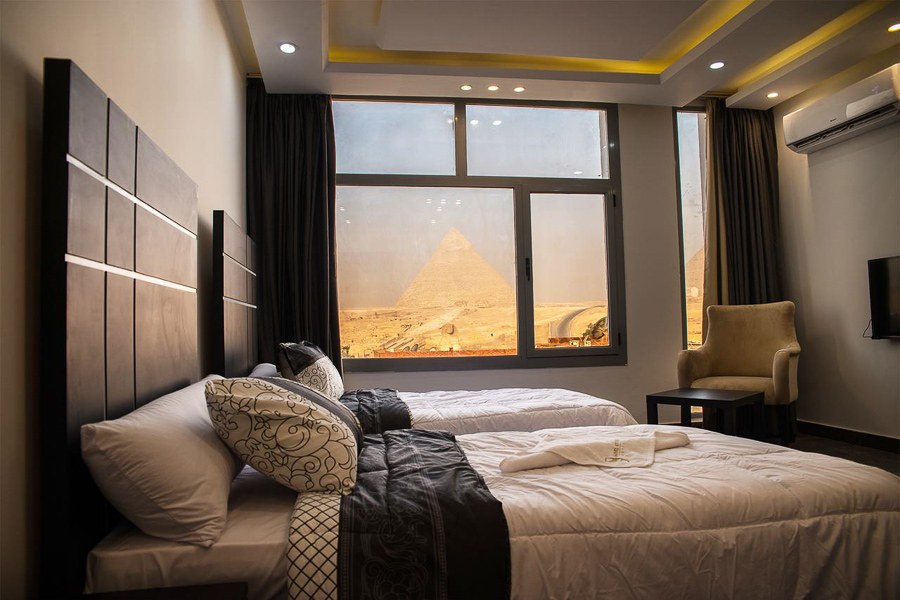
I spent $32 USD per night at the Marvel Stone Hotel, which featured a fantastic rooftop terrace offering views of the pyramids and the sphinx, equipped with comfortable chairs and even a pool table.

This was truly one of the high points of my trip to Giza, as I could relax and appreciate the pyramids and the camels roaming in the distance — all while avoiding harassment from vendors and touts. In the evening, I enjoyed watching the sunset over the Pyramid of Khafre and captured some photos from the rooftop.
What is the ideal time to explore the Giza Pyramids?
Egypt experiences a dry climate, making it hot and arid throughout the year.
The most pleasant months to visit are from December to March, which is likely the peak tourist season for the pyramids; however, any month during spring or fall would also be suitable. I traveled to Egypt in September and found the heat intense at times (especially in Luxor), but it wasn’t unbearable in Giza. Compared to other nearby Middle Eastern nations like Qatar or the UAE, northern Egypt is not as scorching.
Morning is a decent time for photos of the pyramids, but the dust can dull the colors slightly. The optimal time for photography at the pyramids is around noon, when the dust dissipates and the blue sky becomes visible in the background.
Page processed in 5.19 seconds.
Powered by SimplePie 1.3.1, Build 20121030175403. Run the SimplePie Compatibility Test. SimplePie is © 2004–2025, Ryan Parman and Geoffrey Sneddon, and licensed under the BSD License.
